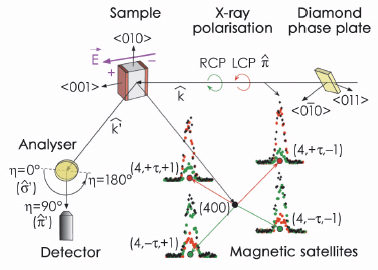- Home
- Users & Science
- Scientific Documentation
- ESRF Highlights
- ESRF Highlights 2009
- Electronic structure and magnetism
- Probing multiferroics using circularly-polarised X-rays
Probing multiferroics using circularly-polarised X-rays
The surprising discovery of a strong coupling between ferroelectric and magnetic order parameters in the transition metal oxide TbMnO3 has led to a resurgence of interest in magnetoelectric multiferroics. TbMnO3 represents a new class of material where the onset of ferroelectricity is driven by the formation of an inversion symmetry breaking non-collinear magnetic order. The large coupling between the two types of order represents a considerable challenge, on the one hand, in terms of understanding its origin, and an opportunity, on the other hand, from the enticing prospect of new types of devices. Key to both endeavours is the need to develop novel techniques for imaging the formation of multiferroic domains under applied external fields.
We have developed the use of circularly polarised X-rays for non-resonant magnetic scattering, and demonstrated how it allows us to gain a complete picture of the complex magnetic structures displayed by the new multiferroics. A particularly appealing aspect of our technique is that it readily enables the imaging of the spatial distribution of magnetic domains. Historically there are few examples of the use of circularly-polarised X-rays in diffraction from non-collinear magnetic systems; however, the handedness of circularly-polarised X-rays naturally couples to the handedness of cycloidal spin structures. When circularly-polarised X-rays are used in combination with a linear polarimetry analysis of non-resonant magnetically-scattered photons, one obtains information about the magnetic structure complementary to that found in neutron diffraction. The polarisation state of the photon is described by the Stokes parameters, and it is through the determination of the Stokes parameters, obtained on exciting the non-resonant magnetic scattering process with circularly-polarised incident X-rays, that one can demonstrate the ability to control the population of the cycloidal magnetic domains by an applied electric field.
In TbMnO3 the relevant phase transition to a non-collinear cycloidal spin arrangement occurs at T = 27 K and is concomitant with the onset of a spontaneous electric polarisation. The two different magnetic sublattices make it a particularly challenging test case for any new magnetic structure refinement method. However, whilst typically magnetic structure refinement requires measuring as many magnetic reflections as possible, here the coupling of the photon polarisation state and the experimental geometry, see Figure 89, enables the refinement using only four satellite magnetic reflections.
 |
|
Fig. 89: Experimental setup and polarisation dependence of (4 ± |
The experimental sensitivity to the imbalance in magnetic domain populations produced by cooling the sample on application of an electric field was initially tested. Figure 89 shows the complementary behaviour of the intensities of four magnetic satellites (4 ±![]() ±1) for left and right circular polarisation (LCP, RCP) depending on the sign of
±1) for left and right circular polarisation (LCP, RCP) depending on the sign of ![]() . This is in strong contrast to the results expected for equi-populated domains, for which the signal should be very similar for LCP (red dots) and RCP (green dots). Also shown are the intensities for linear incident polarisation (black dots), which are similar for all four satellites. On switching the electric field, there is a reversal in the behaviour of the LCP and RCP magnetic satellite intensities, because the direction the magnetic cycloid changes its sense of rotation.
. This is in strong contrast to the results expected for equi-populated domains, for which the signal should be very similar for LCP (red dots) and RCP (green dots). Also shown are the intensities for linear incident polarisation (black dots), which are similar for all four satellites. On switching the electric field, there is a reversal in the behaviour of the LCP and RCP magnetic satellite intensities, because the direction the magnetic cycloid changes its sense of rotation.
Taking advantage of the non-resonant X-ray magnetic scattering cross-section and the coupling between the polarisation state and the experimental geometry, the Stokes dependence of the scattering from different magnetic reflections was measured, and a fit to the data made for different magnetic structure models, see Figure 90. Not only does this technique provide unique insight into the formation of cycloidal domains, leading to a quantitative description of the domain state, but it also allowed the refinement of an earlier magnetic structure model obtained from neutron diffraction studies. In particular, the absolute sense of rotation and the phase shifts of the individual magnetic sublattices has been analysed in detail.
 |
|
Fig. 90: a) Polarisation dependence of magnetic satellites (4 ± |
These techniques present an exciting opportunity for a new class of experiments in which the magnetic state of complex magnetic materials can be probed and the magnetoelectric domain formation controlled under applied external electric and magnetic fields. In the future, the combination of this technique with highly focussed X-ray beams will produce real-space images of the formation of non-collinear magnetic domains.
Principal publication and authors
F. Fabrizi (a,b), H.C. Walker (a,b), L. Paolasini (a), F. de Bergevin (a), A.T. Boothroyd (c), D. Prabhakaran (c), and D.F. McMorrow (b), Phys Rev Lett 102, 237205 (2009).
(a) ESRF
(b) London Centre for Nanotechnology and Department of Physics and Astronomy, University College London (UK)
(c) Department of Physics, Clarendon Laboratory, University of Oxford (UK)



